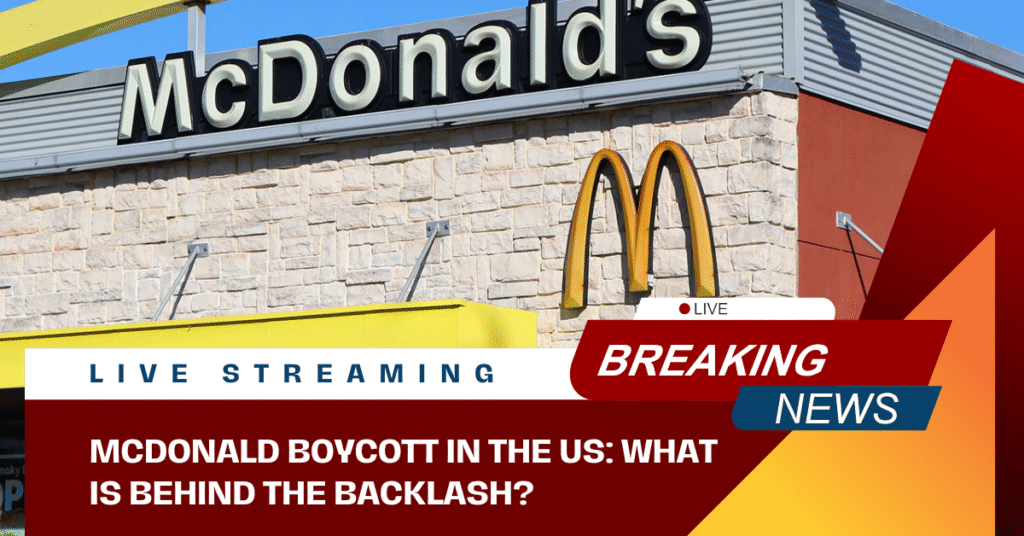
The golden arches, which have represented McDonald’s for many years, are now going through an unparalleled project inside the U.S. A mcdonald boycott against the quick-meals giant has won huge traction, with social media exploding in outrage and thousands of consumers swearing off large Macs, fries, and the entirety in between. But what exactly sparked this boycott? Let’s dive into the core reasons, the ripple consequences, and the lasting consequences this protest may want to have on one of the international’s most recognisable manufacturers.

Why are a Mcdonald boycott?
The McDonald boycott, which kicked off with a viral marketing campaign on social media, stems from a dissimilation of social, ethical, and enterprise-associated issues. At the heart of the protest is a developing dissatisfaction with the enterprise’s perceived lack of company social responsibility and its controversial moves over the last year.
One of the principal issues fueling the boycott is McDonald’s management of hard work disputes. The agency has long faced grievances for its treatment of people, particularly those working in low-salary positions. In line with exertions advocates, McDonald’s has been reluctant to meet demands for higher wages, fitness benefits, and safer operating situations. The maximum current strike via speedy-meals employees over truthful wages has intensified the boycott motion, as activists call for better pay for the vital employees who helped maintain the brand at some point of the pandemic.
The Power of Social Media in Sparking the Boycott
In the trendy digital age, a hashtag can go a long way, and the #BoycottMcDonalds movement has long gone viral. Social media systems like Twitter, Instagram, and TikTok have performed a good-sized function in rallying support for the boycott. Influencers, activists, and normal consumers alike have shared their frustrations, with many vowing to stay far from mcdonald boycott for at least one week. The marketing campaign has been pushed with the aid of grassroots efforts and has reached some distance beyond the typical fast-meals customer base.
What’s at Stake for the mcdonald Boycott?
Because the boycott maintains to benefit momentum, mcdonald boycott has issued statements that explicit their commitment to listening to customer remarks and making enhancements. The agency has emphasised its ongoing efforts to improve hard work situations and reduce its environmental impact. However, critics argue that those statements are too little, too overdue.
The public’s reaction to McDonald’s messaging may be key in determining the long-term effect of the boycott. If the corporation is able to enforce actual, tangible adjustments that deal with the worries of its clients, it would mitigate some of the harm caused by the protest.
The Bigger Picture: Is This the Start of a Larger Trend?
The McDonald boycott is not a remote incident. It represents a bigger fashion of patron activism within the U.S., where customers are increasingly holding businesses liable for their actions. This is a heads-up call for organisations that have long been capable of functioning with minimal scrutiny. In an international market where social justice, environmental responsibility, and truthful hard work practices are becoming extra important to purchasers, agencies have to adapt or chance losing out.
As we circulate into a new era of customer attention, the McDonald’s boycott is just one instance of how the tides are shifting. Businesses across industries will need to pay closer attention to the values and worries of their patron base if they want to avoid turning into the next target of a viral protest.
What Lies Ahead for McDonald?
The outcome of this boycott remains unclear, but one aspect is obvious: the mcdonald boycott is under severe scrutiny. The organisation’s capacity to respond to the concerns of its clients and make giant enhancements in its hard work practices and environmental rules will decide whether or not it can weather this typhoon. because the motion maintains to advantage in momentum, mcdonald boycott will need to decide if it desires to stand with its loyal clients or risk becoming the target of future boycotts.

